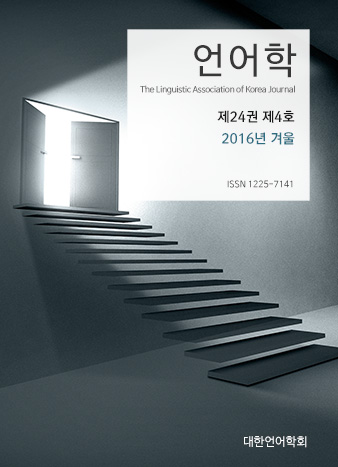대한언어학회 전자저널

-
An Alternative Approach to Realizations of the Medial [nt] Cluster in English
-
Boundary and pitch effects on the perception of Korean alveolar nasal
-
Corpus-Based English Grammar Instruction in a Korean College Context Korean College Context
-
A Study on the Relationship between Self-Efficacy Beliefs and Comprehension in English Reading
24권 4호 (2016년 12월)
- An Alternative Approach to Realizations of the Medial [nt] Cluster in English
-
Chin-Wan Chung
Pages : 1-22
Abstract
Keywords
# constraints # ranking # superfoot # medial cluster # deletion
References
- Avery, P. and S. Ehrlich. (1992). Teaching American English pronunciation. Oxford: Oxford University Press.
- Beckman, J. (1997). Positional faithfulness, positional neutralization and Shona vowel harmony. Phonology, 14, 1-46.
- Beckman, J. (1998). Positional faithfulness. Unpublished doctoral dissertation. University of Massachusetts, Amherst.
- Beckman, J. (2004). Positional faithfulness. In J. McCarthy (Ed.), Optimality theory: a reader (pp. 130-342). Malden, MA: Blackwell Publishing.
- Borowsky, T. (1986). Topics in the lexical phonology of English. Unpublished doctoral dissertation. University of Massachusetts, Amherst.
- Chung, C-W. (2007). A constraint-based account of variation in postnasal /t/ deletion in English. Studies in Modern Grammar, 49, 149-175.
- Chung, C-W. (2009). An asymmetrical realization of nasal-obstruent clusters in English. English Language & Literature Teaching, 15(2), 51-70.
- Davis, S. & Cho, M-H. (2003). The distribution of aspirated stops and /h/ in American English and Korean: an alignment approach with typological implications. Linguistics, 41(4), 607-652.
- Davis, S. (2005). Capitalistic v. militaristic: the paradigm uniformity effect reconsidered. In J. Laura, T. A. Hall, and Renate Raffelsiefen (Eds.), Paradigm in phonological theory (pp. 107-121). New York: Oxford University Press.
- Jensen, J. (2000). Against ambisyllabicity. Phonology, 17, 187-235.
- Ladefoged, P. (2001). A course in phonetics. Fort Worth, TX: Harcourt College Publishers.
- Lombard, L. (1999). Positional faithfulness and voicing assimilation in optimality theory. Natural Language and Linguistic Theory, 17, 267-303.
- McCarthy, J. (1994). The phonetic and phonology of Semitic pharyngeals. In P. Keating (Ed.), Phonological structure and phonetic form: Papers in Laboratory Phonology III (191-233). Cambridge: Cambridge University Press.
- McCarthy, J. J., & Prince, A. (1995). Faithfulness and reduplicative identity. In J. Beckman, L. W. Dickey, and S. Urbancyzk (Eds.), University of Massachusetts Occasional Papers in Linguistics 18 (pp. 249-348). Amherst, MA: GLSA, University of Massachusetts.
- Pater, J. (1996). *NC̥. In K. Kusumoto (Ed), Proceedings of NELS 26 (pp. 227-239). Amherst, MA: GLSA.
- Pater, J. (1999). Autronesian nasal substitution and other NC̥ effects. In R. Kager, H. Van der Hulst & W. Sonneveld (Eds.), The phonology-morphology interface (310-343). Cambridge: Cambridge University Press.
- Pater, J. (2004). Autronesian nasal substitution and other NC̥ effects. In J. McCarthy (Ed.), Optimality theory: a reader (pp. 271-289). Malden, MA: Blackwell Publishing.
- Prince, A. and P. Smolensky. (1993). Optimality Theory: Constraint Interaction in Generative Grammar. Unpublished manuscript. Rutgers University and University of Colorado, Boulder.
- Prince, A. and P. Smolensky. (2004). Optimality theory: constraint interaction in generative grammar. Malden, MA: Blackwell.
- Wolfram, W. & Johnson, R. (2003). Phonological Analysis: Focus on American English. Seoul: Pearson Education Korea LTD.